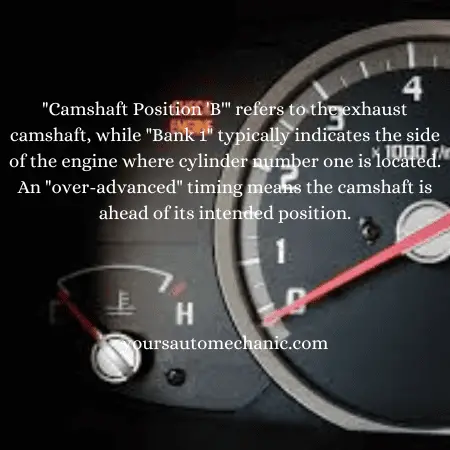Your car’s OBD-II system continuously monitors various systems and components. When it detects something amiss, it triggers a DTC, which can be read using a diagnostic scanner.
Each code points to a specific issue, making troubleshooting more straightforward. In this article, I will discuss the symptoms, causes, and solutions of the P0014 code. So keep on reading…

What Is Code P0014?
Code P0014 stands for “Camshaft Position ‘B’ Timing Over-Advanced or System Performance (Bank 1).” This code indicates that the camshaft timing is too far advanced from where it should be.
This can affect the timing of the engine’s intake and exhaust valves, leading to performance issues. The advanced timing means the camshaft is ahead of the crankshaft, which can cause poor engine performance, increased emissions, and potential damage to the engine over time.
How the Engine Timing System Works
The engine timing system ensures that the valves open and close at the right times during the engine’s cycle. Proper timing is critical for optimal engine performance and efficiency.
Variable Valve Timing (VVT) System
The VVT system adjusts the timing of the valve operation to enhance performance, fuel efficiency, and emissions. It allows for more precise control of the intake and exhaust valve timing.
Camshaft Position ‘B’ Timing Over-Advanced (Bank 1)
In simpler terms, “Camshaft Position ‘B'” refers to the exhaust camshaft, while “Bank 1” typically indicates the side of the engine where cylinder number one is located. An “over-advanced” timing means the camshaft is ahead of its intended position.
Must Read: How To Start A Car With A Bad Crankshaft Sensor

Symptoms of Code P0014
When your car has a P0014 code, you might notice several symptoms that indicate something is wrong with the engine timing. Here are some common symptoms:
Check Engine Light: The most obvious sign is that the check engine light will turn on. This is the car’s way of telling you there’s an issue that needs attention.
Engine Performance Issues: You might experience rough idling, misfires, or difficulty starting the engine. The engine may also run unevenly or feel sluggish.
Decreased Fuel Efficiency: If the timing is off, your engine won’t run as efficiently, leading to increased fuel consumption and fewer miles per gallon.
Poor Acceleration: You may notice that your car doesn’t accelerate as quickly or smoothly as usual. This is because the timing affects how well the engine can generate power.
Strange Noises: You might hear unusual sounds from the engine, such as ticking or knocking. These noises can result from the timing being off and components not working in sync.
Increased Emissions: The car may produce more exhaust emissions than usual due to inefficient combustion. This can lead to a failed emissions test.
Stalling or Hesitation: The engine might stall or hesitate when you try to accelerate, especially at low speeds.
If you notice any of these symptoms, it’s important to get your car checked by a professional mechanic to diagnose and fix the underlying issue causing the P0014 code.
You May Find Helpful
- Can Low Oil Cause Misfire? Explained In Detail
- Why My Car Won’t Accelerate But RPMs Go Up? Explained
- How Do I Stop My Brakes From Squeaking In Reverse? ( 6 Steps )

Causes Of P0014 Code
Several factors can cause the P0014 code, indicating an issue with the camshaft position timing. Here are the common causes:
Dirty or Low Engine Oil: Oil is crucial for the proper functioning of the variable valve timing (VVT) system. Dirty or insufficient oil can lead to problems with the camshaft actuator.
Faulty Camshaft Actuator: The camshaft actuator adjusts the position of the camshaft. If it’s malfunctioning, it can cause the timing to be off, leading to the P0014 code.
Defective Variable Valve Timing (VVT) Solenoid: The VVT solenoid controls the flow of oil to the camshaft actuator. A faulty solenoid can disrupt this flow, causing timing issues.
Timing Chain or Belt Problems: A worn or stretched timing chain or belt can affect the synchronization between the crankshaft and camshaft, triggering the P0014 code.
Electrical Issues: Problems with the wiring or connectors to the camshaft actuator or VVT solenoid can prevent these components from functioning correctly.
Faulty Engine Control Module (ECM): Although less common, a malfunctioning ECM can send incorrect signals to the camshaft actuator, causing timing issues.
Sludge Buildup: Sludge in the engine can block oil passages and affect the VVT system, leading to improper camshaft timing.
Addressing these causes typically involves inspecting and possibly replacing the affected components, ensuring clean and sufficient engine oil, and checking the electrical connections related to the VVT system.
Diagnosing and Fixing Code P0014
Step 1: Check the Engine Oil
Start by opening the hood of your car and locating the oil dipstick.
Pull out the dipstick, wipe it clean, reinsert it, and then pull it out again to check the oil level. If it’s low, add oil.
Look at the color and consistency of the oil. If it’s dark and dirty, it’s time for an oil change.
Step 2: Change the Oil and Filter (if needed)
Place a container under the oil drain plug, remove the plug, and let the old oil drain out.
Remove the old oil filter and install a new one.
Put the drain plug back in place, then add the manufacturer-recommended oil to the engine.
Step 3: Use an OBD-II Scanner
Plug an OBD-II scanner into your vehicle’s diagnostic port, usually located under the dashboard.
Turn on the ignition and follow the scanner’s instructions to read the stored codes.
Clear the codes from the scanner and see if the P0014 code comes back after a test drive.
Step 4: Inspect the Camshaft Position Sensor
Find the camshaft position sensor in your engine bay.
Inspect the sensor and its wiring for any signs of damage or wear.
If the sensor looks damaged, replace it with a new one.
Step 5: Check the Variable Valve Timing (VVT) Solenoid
Find the VVT solenoid near the camshaft in your engine.
Check the solenoid and its wiring for any visible problems.
Remove the solenoid and clean it if it’s dirty. If cleaning doesn’t fix the issue or it’s faulty, replace it with a new one.
Step 6: Inspect the Camshaft Actuator
Find the camshaft actuator in your engine.
Look for any signs of wear or damage.
If the actuator is damaged, replace it with a new one.
Step 7: Examine the Timing Chain or Belt
Remove the timing chain or belt cover to inspect the condition.
Look for signs of wear, stretching, or improper tension.
If the timing chain or belt is worn or stretched, replace it.
Step 8: Check Electrical Connections
Check the wiring and connectors for the camshaft position sensor, VVT solenoid, and camshaft actuator.
Repair or replace any damaged wiring and ensure all connections are secure.
Step 9: Reprogram or Replace the Engine Control Module (ECM)
If you suspect the ECM is faulty, have it tested by a professional.
If needed, reprogram the ECM to ensure it’s sending correct signals and If reprogramming doesn’t help, replace the ECM with a new one.
Step 10: Reset the Check Engine Light
Connect the scanner again and clear any stored codes.
Take your car for a test drive to make sure the P0014 code doesn’t reappear and the check engine light stays off.
Cost Of Fixing P0014 code
The cost to fix a P0014 code can vary widely depending on the underlying cause and the type of vehicle you have.
The total cost to fix a P0014 code can range from as low as $30 for an oil change to over $1,500 for more extensive repairs like timing chain replacement or ECM replacement. On average, most repairs will fall between $150 and $600.
It’s important to have a professional mechanic diagnose the issue accurately. They can pinpoint the exact cause of the P0014 code, which helps avoid unnecessary repairs and expenses. The cost for a professional diagnosis is typically around $75 to $150.
Factors Influencing Cost
- Vehicle Make and Model: Luxury and high-performance vehicles tend to have higher repair costs.
- Location: Labor rates can vary depending on your location. Urban areas often have higher rates than rural areas.
- Severity of the Issue: The complexity of the repair needed will impact the cost.
Always get a detailed estimate from your mechanic before proceeding with repairs to understand the potential costs involved.
Must Read
- What Is The P1682 Code? Symptoms | Causes | Solutions
- 7E8 Engine Code – Symptoms | Causes | Troubleshooting
- P0008 Code But Car Runs Fine – Its Causes & Potential Action
- How Do I Fix Code C1201- Step By Step Guide
Conclusion
Code P0014 might seem like a random jumble of letters and numbers, but it signals a crucial issue with your car’s engine timing. Understanding what it means, how to diagnose it, and the steps to fix it can save you from hefty repair bills and keep your vehicle running smoothly. Regular maintenance, attention to detail, and using quality parts are key to preventing such issues.
